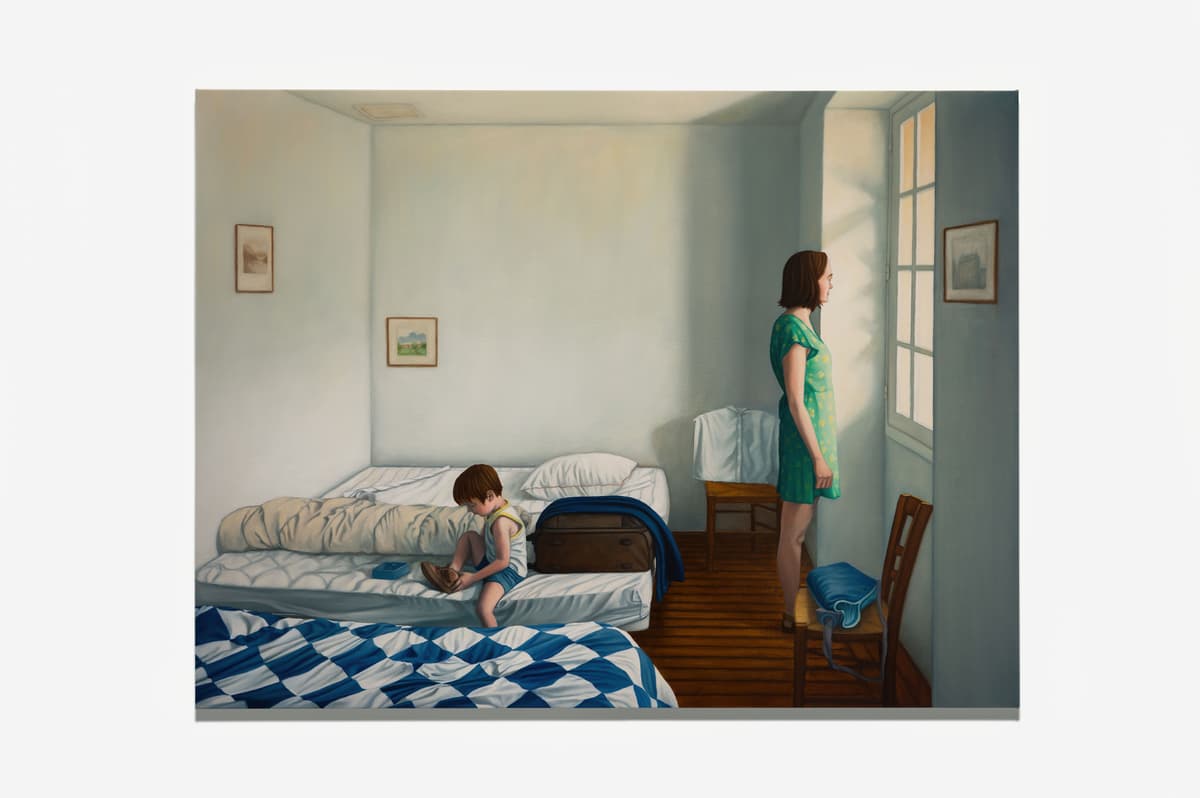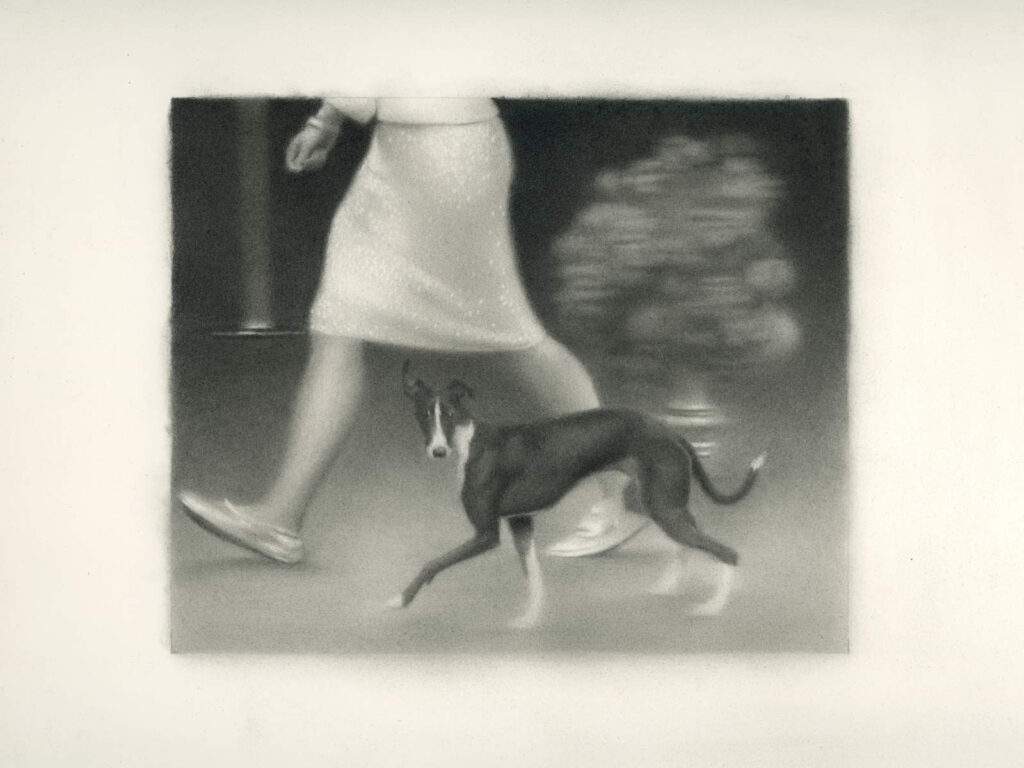Realism’s Latest Moment Suggests Tensions Between the Representational and the Surreal
What’s driving the renewed fascination with the representational? The fact that realism is, for better or for worse, the chosen visual idiom of AI offers a clue.

Nick Hobbs: ‘Out there, Somewhere’
STORAGE: APT Gallery, 52 Walker Street, 4th floor, New York, NY
Through November 16, 2024
Dorian Cohen: ‘The Promise of Blue’
Long Story Short Gallery, 54E Henry Street, New York, NY
Through November 17, 2024
Realism is having another moment, as it has had in perennial cycles throughout the last century. The most current wave seems less indebted to historical revivalism, however, and more interested in the uncanny valley between the representational and the surreal. Two different shows below 14th Street showcase these tensions in separate mediums: A series of cryptic black and white graphite drawings by New York artist Nick Hobbs, and a series of quiet interiors by Parisian painter Dorian Cohen.
STORAGE: APT is a boutique art space adjunct to the main gallery tucked onto the Bowery. It is the ideal venue for Mr. Hobbs’s intimate, photorealistic drawings, small miracles of graphite legerdemain that evoke black and white photography as much as they do cinema. There is an echo of Hitchcock in the way Mr. Hobbs situates his subjects. Like him, Mr. Hobbs favors either the remote long shot or the extreme close-up, and he alternates them throughout the show. Both perspectives are imbued with a certain coldness.
In other words, Mr. Hobbs is either cosmically removed or intensely close. There is a glowing study of a Tiffany stained-glass lamp, a facial closeup of a distinctly uncomfortable man, a scarred Greenland shark in frigid arctic waters, orbital shots of the moon, and vast fields of stars. All are rendered in grayscale photo realism that mimics camera snapshots from the 1950s.
Some have distinctly whimsical subject matter, such as the legs and feet of a woman walking a whippet through a city. Another of a skyscraper in forced, nearly Bauhaus, perspective from below, by contrast, is practically formalist. They are disorienting in perspective, style, and approach, even with their apparently uniform patina of technical perfection.

For starters, where is the eye behind these drawings located? It’s uncertain, since their vintage quality makes them hard to situate in either place or time. One of the moon drawings, in fact, has a single bright wink of light, like the flash of a mirror or even the impact of a meteor. Is it from decades ago, or a billion years ago? Mr. Hobbs seems to be engaging in perspectives that are not privy to any observer, placing cosmic and human scales side by side.
Long Story Short, an international gallery devoted to the spectrum of new realism, is showing the interiors of Dorian Cohen. They have a cool stillness far more indebted to the psychology of his subjects than to manipulations of perspective or medium. Unlike Mr. Hobbs, they are firmly situated in the human world. Mr. Cohen’s figures, all of whom perform mundane domestic activities, inhabit their frames like characters in a miniature drama. A couple eats breakfast, backs turned to each other. A man rubs himself dry with a towel standing at a bathroom mirror. A young woman considers her hands on a yellow bed.
The images have a precision of form and brightness of palette that makes each moment seem cinematically staged or framed. Yet these are moments of presentational privacy, too filmically precise in their imperfections and details to be truly real. Mr. Cohen, who is Paris-based, has managed to create windows of contemporary cinema verité. He elevates domestic moments to the level of a waking dream: there is an uncanny precision to them that recalls Alex Colville, or David Hockney, but rendered in unmistakable French style.
Mr. Cohen’s strength also lies in his ability to make each of his figures radiate a strong sense of interiority. We’re not privy to the mind of the man tousling his head with a towel, or to the thoughts of the breakfasting couple, but we can sense their intensity. He also likes to catch them, like the mother and son in a bedroom, as they are immersed in shared but separate moments.
Mr. Cohen relishes these glimpses of shared intimacy where each person, in some sense, is locked into their private thoughts. The effect is both alienating and strangely touching, as if he were using his figures to portray a certain shade of loneliness and vulnerable melancholy that has become endemic in the last few years.
It’s hard to know what is driving the renewed fascination with the representational, except to say that in today’s Netflix and Apple TV saturated environment we are continuously immersed in nearly every era of the last 2000 years, as well as the far-flung future, all recreated in increasingly sumptuous detail.
Today,history seems to be thought of less as a straight, undeviating line from a remote past to the present. We appear to be living in a field of “all-time,” where our growing ability to simulate the past seemingly grants us access to all eras at once. No doubt this is also driven by the fact that realism is, for better or for worse, the chosen visual idiom of AI — an AI heavily supported by and indebted to a database of endless Bollywood movie posters, as it turns out.
At least for now, though, it seems that the subtlest impressions of the human eye translated into the tiny registers of the human hand is still entirely unique and untranslatable into any machine language. We may also soon come to understand also that “realism,” as it is previously understood, is perhaps only the most detailed form of abstraction. All art is, perhaps, to quote John Ashberry, “a movement out of the dream into its codification.”

